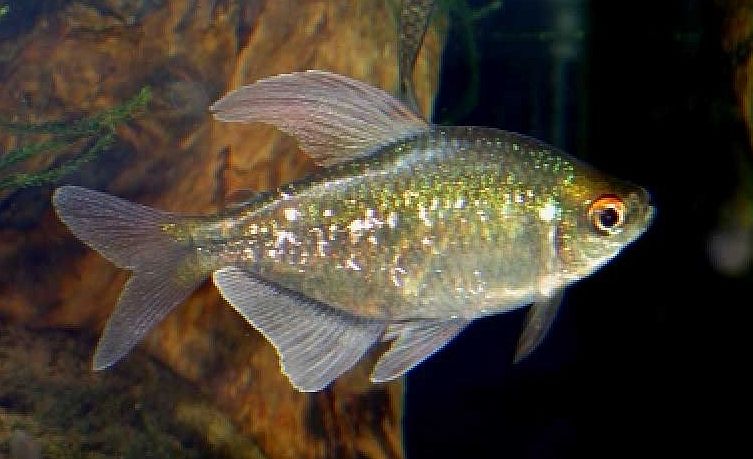The Diamond Tetra (Moenkhausia pittieri) is found only in Venequela’s Lake Valencia and the surrounding waters. Because of agricultural and industrial pollution, Lake Valencia is subject to regular algae blooms which tend to isolate the Diamond Tetra in shallow, vegetated parts of the lake and in several of its slow moving tributaries. Most fish sold to tropical fish keeping enthusiasts have been bred in the commercial fish farms of the Far East and Eastern Europe.
The Diamond Tetras body scales are highly reflective and almost shimmer in the light of an aquarium. Their overall color is silver with greenish blue to violet highlights that glitter in the light.
Mature males display beautiful ventral, anal, and an elongated dorsal fin, that like the male Bleeding Heart Tetra, trails to almost the tail of the fish.
Males are larger and less stockily built than the females. Their scales are also much more reflective than those of the females.
Diamond Tetras are shoaling fish that do best with at least 6 to 8 in an aquarium environment. Usually one male becomes dominant and will keep the other males in their place, to remind them of the “pecking order”. They make excellent companions for most other tetras, live bearers, danios, rasboras, and peaceful bottom dwellers such as Corydoras and the smaller Loricariids. The majority of the more commonly available gouramis and dwarf cichlids are also compatible with a small school of Diamond Tetras.
Diamond Tetras are easy fish to keep and breed.
They prefer moderately hard, slightly acidic water, but will adjust to harder water with a slightly higher pH. Ideally, they should be housed in a densely planted tank with a sandy or fine gravel substrate and a few pieces of driftwood. They do not require the addition of a power head for current, and are good candidates for peaceful community tanks.
With plenty of fine leaved plants in an aquarium, you may occasionally find babies showing up in your community tank. If you want more survivors from a spawning, place either a conditioned spawning pair, or a half dozen fish of each sex in a separate tank with dim lighting and plenty of fine leaved plants like Cabomba, Java Moss, or spawning mops.
The tank water should be soft and acidic; around pH 5.5-6.5, gH 1-5, and a temperature of 80-84°F and filtered through a small air powered sponge. Many breeders filter the water through peat bags to improve productivity and help keep the eggs from developing fungal problems.
If you transfer a conditioned female with the best colored male into the breeding tank in the evening, they should spawn the following morning. When spawning is completed, remove the adults and withing 24 to 36 hours, the eggs will hatch out. Fry are free swimming after 3 to 4 days and should be fed infusoria until they are large enough to accept baby brine shrimp or .
Feeding Diamond Tetras is not a problem. They will eagerly accept quality flake foods as well as live, frozen, or freeze dried daphnia, bloodworms
, brine shrimp, tubifex
, etc.
Diamond Tetras are usually available for purchase when they are 1/2″ to 1″ in size.
Minimum Tank Size: 10 gallons
Care Level: Moderate
Temperament: Peaceful
Water Conditions: 75-82° F, KH 4-8, pH 6.0-7.5
Max. Size: 2 1/2″
Color Form: Silver, White
Diet: Omnivore
Compatibility: Community Tanks
Origin: Venezuela (Lake Valencia)
Family: Characidae
Life Span: 7 years
Aquarist Level: Beginner




